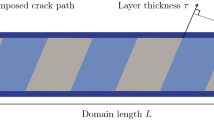Abstract
Fracture of the adhesive layer (AL) of finite thickness with elastoplastic properties in a layered composite is considered in this article. The expression of the \({J}_{C}\)-integral is obtained as the sum of values of the products of the layer thickness and the increments of the specific free energy and specific dissipation. Based on the variational formulation, a solution to the model problem of shear action on a thin elastoplastic layer is obtained. From the analysis of the solution obtained, it follows that in the case of a layer degenerating into a mathematical section, the main contribution to the representation of the \({J}_{C}\)-integral is made by the term responsible for the energy dissipation, and the energy product tends to zero. In this case, it is not pure dissipation that is considered, this is the product of specific dissipation and layer thickness. The expression of the \({J}_{C}\)-integral is obtained in terms of the quantities measured in a possible experiment.


Similar content being viewed by others

References
Berto F, Lazzarin P (2007) Relationships between J-integral and the strain energy evaluated in a finite volume surrounding the tip of sharp and blunt V-notches. Int J Solids Struct 44:4621–4645
Berto F, Lazzarin P, Matvienko YG (2007) J-integral evaluation for U- and V-blunt notches under Mode I loading and materials obeying a power hardening law. Int J Fract 146(1–2):33–51
Berto F, Glagolev VV, Markin AA (2018) A body failure model with a notch based on the scalable linear parameter. PNRPU Mech Bull 4:93–97
Cherepanov GP (1967) Crack propagation in continuous media. J Appl Math Mech 31(3):503–512
Cherepanov GP (2012) Some new applications of the invariant integrals of mechanics. J Appl Math Mech 76(5):519–536
Eshelby JD (1951) The force on an elastic singularity. Philos Trans R Soc A 244:87–112
Fang X, Charalambides PG (2017) A J-integral approach in characterizing the mechanics of a horizontal crack embedded in a cantilever beam under an end transverse force. Eng Fract Mech 169:35–53
Fraisse P, Schmit F (1993) Use of J-integral as fracture parameter in simplified analysis of bonded joints. Int J Fract 63(1):59–73
Glagolev VV, Markin AA (2019) Fracture models for solid bodies, based on a linear scale parameter. Int J Solids Struct 158:141–149
Glagolev VV, Markin AA, Fursaev AA (2016) Separation process modeling of composite with adhesive layer. PNRPU Mech Bull 2:34–44
Hutchinson JW (1968) Singular behavior at the end of a tensile crack tip in a hardening material. J Mech Phys Solids 16:13–31
Jain LK, Mai Y (1994) Analysis of stitched laminated ENF specimens for interlaminar mode II fracture toughness. Int J Fract 68:219–244
Khoshravan M, Asgari Mehrabadi F (2012) Fracture analysis in adhesive composite material/aluminum joints under mode-I loading; experimental and numerical approaches. Int J Adhes Adhes 39:8–14
Kim T-U (2013) The J-integral for single-lap joint using the stress field from the mixed variational principle. Acta Mech 224(11):2611–2622
Kolednik O, Schöngrundner R, Fischer FD (2014) A new view on J-integrals in elastic–plastic materials. J Fract 187(1):77–107
Lavit IM (2001) Energy balance of the crack tip neighborhood in elastoplastic medium. Izv RAN MTT 3:123–131 (In Russian)
Livieri P, Segala F (2007) Analytical evaluation of J-integral for elliptical and parabolic notches under mode I and mode II loading. Int J Fract 148(1):57–71
Matvienko YG, Morozov EM (2004) Calculation of the energy J-integral for bodies with notches and cracks. Int J Fract 125(3–4):249–261
Ojalvo IU, Eidinoff HL (1978) Bond thickness effects upon stresses in single-lap adhesive joints. AIAA J 16:204–211
Rice JR (1968a) A path independent integral and the approximate analysis of strain concentration by notches and cracks. ASME J Appl Mech 35:379–386
Rice JR (1968b) Mathematical analysis in the mechanics of fracture. In: Liebowitz H (ed) Fracture—an advanced treatis, vol 2. Academic Press, New York, pp 191–311
Rice JR, Drugan WJ, Sham TL (1980) Elastic–plastic analysis of growing cracks. ASTM STP 700:189–221
Santos MAS, Campilho RDSG (2017) Mixed-mode fracture analysis of composite bonded joints considering adhesives of different ductility. Int J Fract 207(1):55–71
Serier N, Mechab B, Rachid M, Serier B (2016) A new formulation of the J integral of bonded composite repair in aircraft structures. Struct Eng Mech 58(5):745–755
Simha NK, Fischer FD, Shan GX, Chen CR, Kolednik O (2008) J -integral and crack driving force in elastic-plastic materials. J Mech Phys Solids 56:2876–2895
Taib AA, Boukhili R, Achiou S, Gordon S, Boukehili H (2006) Bonded joints with composite adherends. Part I. Effect of specimen configuration, adhesive thickness, spew fillet and adherend stiffness on fracture. Int J Adhes Adhes 26(4):226–236
Tresca H (1868) Memoire sur l’ecoulement des corps solides. Mem pres par div savants 18:733–799
Truesdell C, Noll W (1965) The non-linear field theories of mechanics. Encyclopedia of Physics. Springer, Berlin
Turon A, Dávila CG, Camanho PP, Costa J (2007) An engineering solution for mesh size effects in the simulation of delamination using cohesive zone models. Eng Fract Mech 74(10):1665–1682
Volkersen O (1938) Die Nietkraftverteilung in zugbeanspruchten Nietverbindungen mit konstanten Laschenquerschnitten. Luftfahrtforschung 15:41–47
Acknowledgements
The reported study was funded by Russian Foundation for Basic Research according to the research Project No. 19-41-710001 p_a.
Author information
Authors and Affiliations
Corresponding author
Additional information
Publisher's Note
Springer Nature remains neutral with regard to jurisdictional claims in published maps and institutional affiliations.
Rights and permissions
About this article
Cite this article
Berto, F., Glagolev, V.V. & Markin, A.A. Relationship between \({J}_{c}\) and the dissipation energy in the adhesive layer of a layered composite. Int J Fract 224, 277–284 (2020). https://doi.org/10.1007/s10704-020-00464-0
Received:
Accepted:
Published:
Issue Date:
DOI: https://doi.org/10.1007/s10704-020-00464-0



